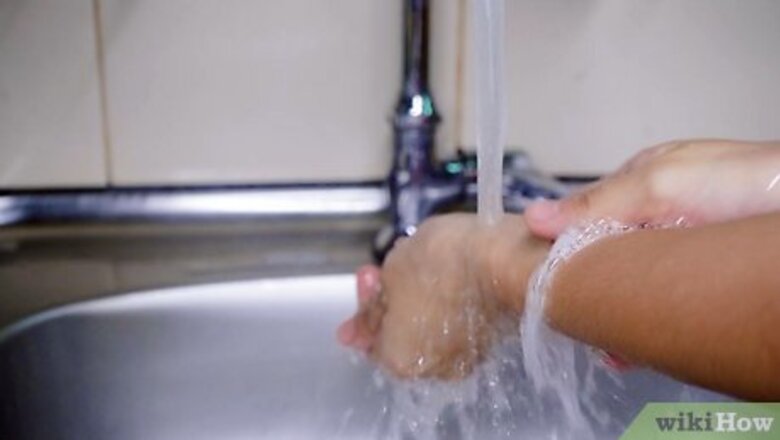
views
Preparing Sauerkraut for Canning
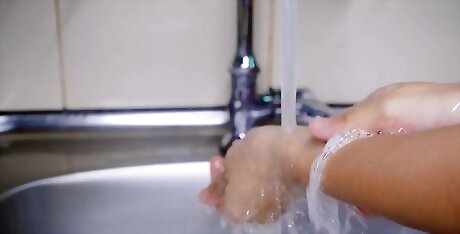
Clean everything. Wash all the supplies you need for making sauerkraut in hot, soapy water. Dry thoroughly with a clean dish towel or clean paper towels. Sauerkraut is made when cabbage undergoes fermentation. In order for the "good," beneficial bacteria to successfully start the fermentation process, potentially harmful bacteria should be as scarce as possible. You should also make sure that your hands are thoroughly washed, as well. You can wash the canning jars at this point, but since it will still be several days or weeks before you can can the sauerkraut, it might be more beneficial for you to sanitize the jars the same day you intend to can.
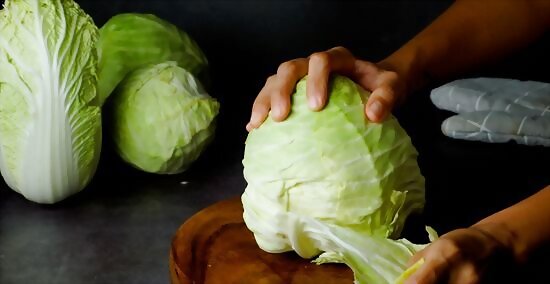
Discard the outer cabbage leaves. Peel away the outer leaves of the cabbage, which often look wilted and limp. You should also remove any leaves that appear to have been damaged by insects or other sources. Work with 5 lbs (2250 g) of cabbage at a time. Do not attempt to work with the whole batch at once, since doing so can make it difficult for the cabbage to ferment properly.
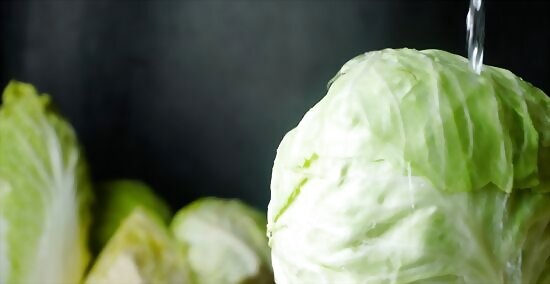
Rinse the cabbage. Clean the cabbage by rinsing it under cool, running water. Let drain into a colander or over several layers of clean paper towels.
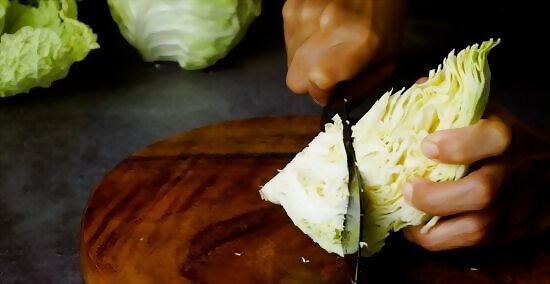
Cut and core. Cut the cabbage heads into quarters. With the core pieces now exposed, cut them out, as well. To make the cabbage easier to work with, you might even wish to cut each head into eighths.
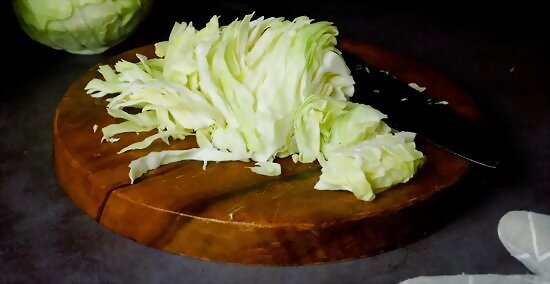
Shred or slice the cabbage. Use a knife, box shredder, or food processor to create finely shredded strips of cabbage from each quarter. Each ribbon should be about 1/16 inch (1.5875 mm) wide. If using a knife, slice across each quarter or eighth crosswise, naturally separating the leaves into ribbons. You could also use a food processor with a slicing attachment or a mandoline. Remove any especially large or tough pieces from the pile of shredded cabbage and discard.
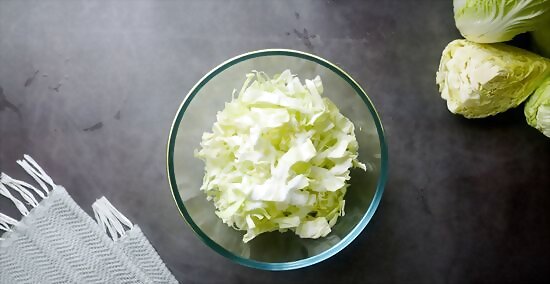
Combine the cabbage and pickling salt. Stir in 3 Tbsp (45 ml) of salt per 5 lb (2250 g) of cabbage. Mix well to combine. Place the shredded cabbage into a large stone crock, large glass bowl, or large food-grade plastic container. Do not use metal or any container that is not approved for use with food or drink. After mixing the pickling salt and cabbage together with your hands, let the cabbage stand unattended for 15 minutes. The juices should begin to flow during this time, and you should notice the cabbage starting to wilt.
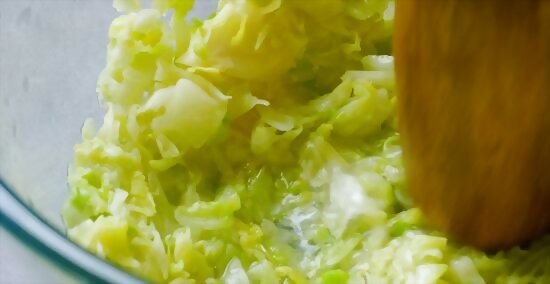
Press firmly. Use your hands or a wooden spoon to press down on the cabbage, causing juice to rise to the surface of the shredded leaves. Repeat the entire procedure four more times to use up the remaining 20 lb (9 kg) of cabbage. Sprinkle any leftover salt over all the cabbage evenly. You should make sure that there is at least 4 inches (10 cm) of space between the cabbage and the rim of the container.
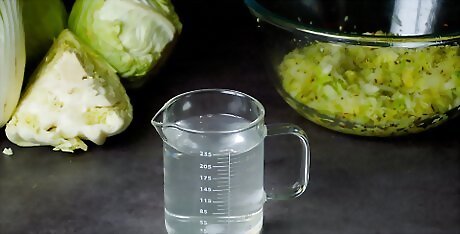
Add brine, if necessary. If you did not manage to squeeze out enough juice to cover the surface of the cabbage completely, you should prepare a brine of water and salt to pour over the cabbage, instead. Prepare a brine by combining 4 1/2 tsp (22.5 ml) pickling salt and 4 cups (1 L) of water in a saucepan. Bring the mixture to a boil over medium-high heat, stirring occasionally to dissolve the salt. Remove it from the heat and let it cool to room temperature. Once cool, you can ladle or pour it over the sauerkraut.
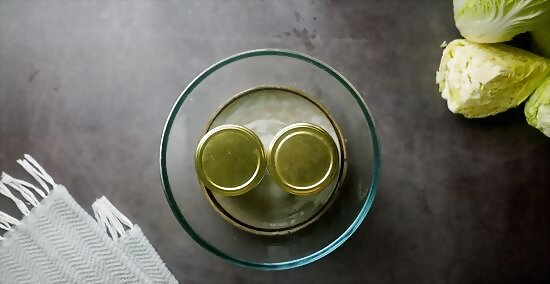
Weigh it all down. Place a large, inverted plate over the cabbage mixture. Set two or three sealed quart-size (liter-size) jars filled with water on top of the plate to weigh it down and continue pressing the cabbage. Cover the entire dish with a clean, heavy towel or piece of cheesecloth. Let the dish sit in a cool place.
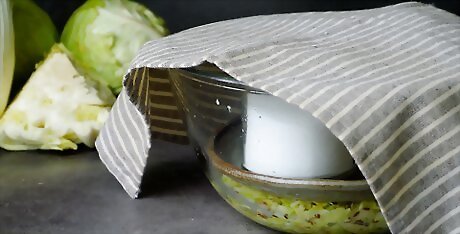
Let the cabbage ferment. Watch the dish of cabbage daily. Gas bubbles form during the fermentation process, so once these bubbles stop forming, you can conclude the fermentation is complete and the sauerkraut is ready to either enjoy or can. Fermentation can take as little as 3 days and as long as 6 weeks. Large batches like this one usually take at least 3 weeks, though, and may require the full 6 weeks. Keep the sauerkraut out of direct sunlight. Note that the ideal temperature conditions are between 65 and 75 degrees Fahrenheit (18 to 24 degrees Celsius). Each day, you should remove and discard any white scum that forms on the surface of the cabbage. This scum is a healthy, natural bi-product of the chemical fermentation process, but it should still be skimmed off to prevent too much from building up. If any mold forms, skim it and discard it immediately. Make sure that the cabbage is fully submerged before pressing forward. Any part that was near the surface, where the mold was, should be discarded, but the rest is still fine.
Hot Packing Sauerkraut
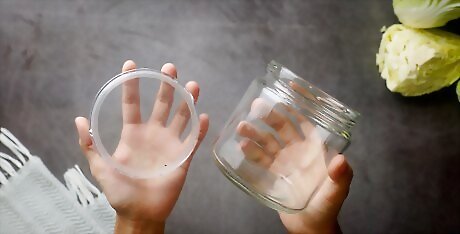
Sanitize the jars. Fill a boiling water canner with water and let that water reach a simmer. Place the glass canning jars and lids inside the water for a few minutes. If using canning jars with two-piece lids, sanitize the main part of the lid in this manner but set the band or ring aside. This can be cleaned in hot, soapy water but not in the simmering water of the canner. Do not boil the water at this time. Note that other types of canners are not recommended for canning sauerkraut.
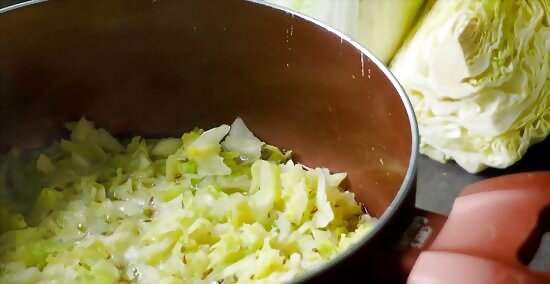
Bring the sauerkraut to a steady simmer. Place the fermented sauerkraut and its brine in a large stainless steel saucepan or stockpot and set it on the stove. Bring it all up to a simmer over medium-high heat. Stir frequently as it cooks. Do not allow it to reach a rolling or rapid boil. Remove from the heat once the simmer is consistent and the sauerkraut is heated through.
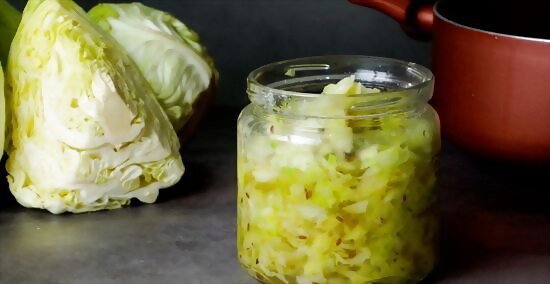
Fill the canning jars with hot sauerkraut. Scoop the sauerkraut out of the saucepan and transfer it immediately to your prepared canning jars. Pack the sauerkraut and brine into each jar tightly, leaving 1/2 inch (1.25 cm) of empty headspace at the top of the jar. If you do not leave enough headspace, the pressure inside the jar might build up and cause it to burst during the canning process. Tap on the side of the jar with your fingers or a metal utensil to gently remove the air bubbles trapped inside. Adjust headspace as necessary by adding more brine. Wipe the rim of the jar with a clean towel before applying the lid and the band on top. The fit should be "fingertip" tight, or as tight as you can screw it on with your fingertips.
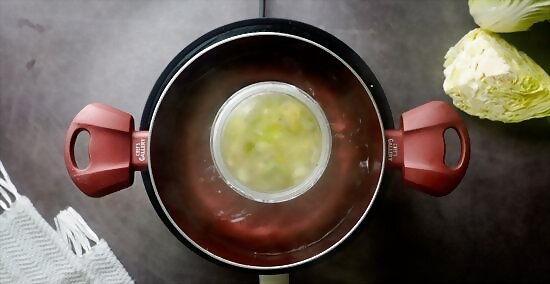
Process the jars. Gently lower your jars of sauerkraut into the boiling water canner using jar tongs. Let them boil, on average, 10 minutes for pint (1/2 L) jars and 15 minutes for quart (L) jars. You may need to adjust for altitude, though. At an altitude between 0 and 1000 feet (305 m), process pint (1/2 L) jars for 10 minutes. Change this to 15 minutes for altitudes between 1000 and 6000 feet (305 and 1830 m) and 20 minutes for those above 6000 feet (1830 m). At an altitude between 0 and 1000 feet (305 m), process quart (L) jars for 15 minutes. Change this to 20 minutes for altitudes between 1000 and 6000 feet (305 and 1830 m) or 25 minutes for those about 6000 feet (1830 m).
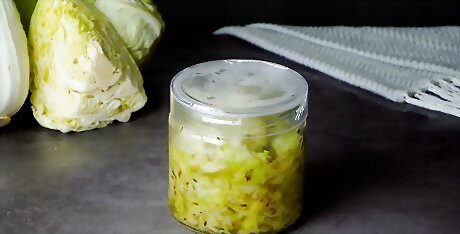
Store your canned sauerkraut. Use jar tongs to lift the jars of sauerkraut out of the water when ready. Remove the jars and let them cool at room temperature before placing them in long-term storage. Check the center button in the middle of each lid after 24 hours pass. This button should not move up and down when you press it. If it does, the sauerkraut has not been properly canned and should be consumed within a week or so. The cans that have properly sealed can be stored in a dark, cool, and dry cupboard for up to 2 to 3 years.
Raw Packing Sauerkraut
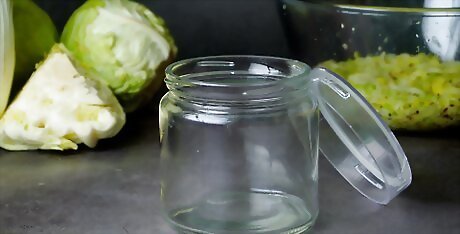
Sanitize the jars. The jars and lids should be sanitized in hot water prior to use. Fill your boiling water canner with water and bring that water to a simmer. Place the glass canning jars in the water so that they are completely submerged and filled with the simmering water. Add your lids, as well. Do not sanitize the band or ring of the lid in this manner, though. These can be washed in plain hot, soapy water. Do not let the water boil. Remove the cans and lids after a few minutes. Note that only a boiling water canner is recommended for canning sauerkraut. Do not try other canners.
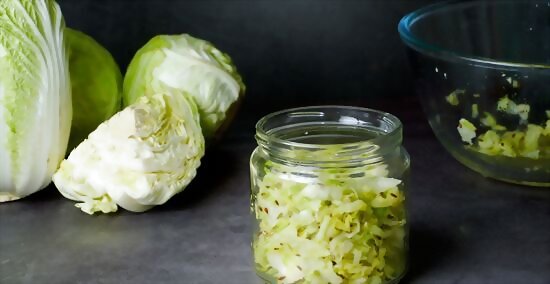
Fill the canning jars with cool sauerkraut. Back the raw, cool sauerkraut and brine into the hot jars, leaving about 1/2 inch (1.25 cm) of empty headspace at the top of the jars. Pack the sauerkraut in firmly. The sauerkraut and pressure inside the jar can expand during the canning process. If you pack the jars too full, you may end up causing them to burst open as the sauerkraut sits in the canner. Use a metal spoon or your hand to tap on the side of the jar, gently removing the air bubbles trapped deep down. If you need to fill up more headspace afterward, add more brine. Wipe the rim of the jar clean with a clean towel or paper towel. Center the lid on top of the mouth of the jar. Screw the band on over the lid as tightly as possible.
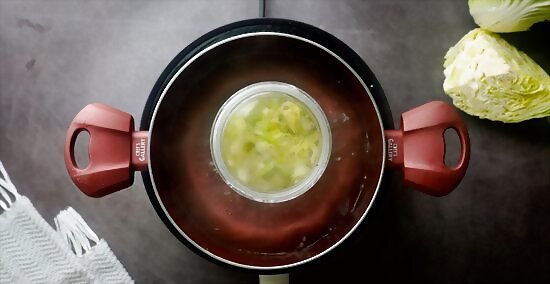
Process the jars. Use jar tongs to carefully lower each jar into the boiling water canner. Bring the water to a boil and let the jars of sauerkraut process for 20 minutes if using pint (1/2 L) jars or 25 minutes if using quart (L) jars. Note that the above processing times only apply if you are at an altitude between 0 and 1000 feet (0 and 305 m). If you are at a higher altitude, you will need to adjust the processing time. At an altitude between 1000 and 3000 feet (305 and 914 m), process pint (1/2 L) jars for 25 minutes. Change this to 30 minutes for altitudes between 3000 and 6000 feet (914 and 1830 m) and 35 minutes for those above 6000 feet (1830 m). At an altitude between 1000 and 3000 feet (305 and 914 m), process quart (L) jars for 30 minutes. Change this to 35 minutes for altitudes between 3000 and 6000 feet (914 and 1830 m) and 40 minutes for those above 6000 feet (1830 m).
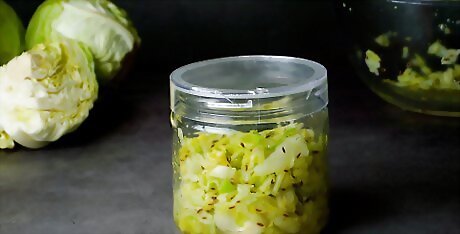
Store your canned sauerkraut. Lift the processed jars out of the canner using jar tongs. Place them gently on soft dish towels and let cool completely, at room temperature, before placing them in long-term storage. Press down on the center of each lid after 24 hours. If the center moves up and down, the sauerkraut has not been properly canned and you should consume it within a week or so. If the jars are properly sealed, though, you can store them unopened in a dark, cool place for up to 2 to 3 years.
















Comments
0 comment